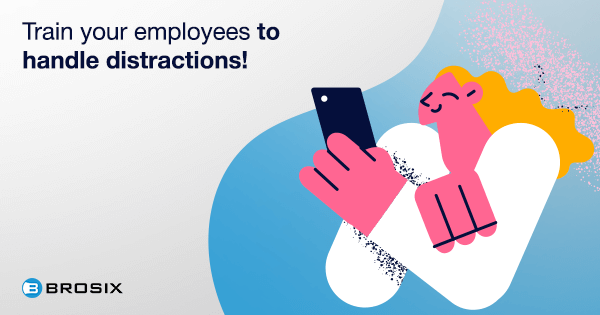Communication is a necessary tool for success in any work environment. We communicate predominantly through words, but in the modern digital world, written communication is also a must. Poor communication due to breakdowns often results in conflict and stress, especially when it happens in the workplace.
These types of communication breakdowns occur when one or both parties misunderstand what the other is saying. This is especially prevalent in work-from-home situations. Digital communication is less personal, which can create a breeding ground for unproductive communication and misunderstandings.
If not handled correctly, workplace miscommunication can result in low morale, decreased productivity, and a less friendly work environment, which is something you should avoid at all costs.
In this article, we’ll discuss different ways in which you can recognize, handle and prevent common communication breakdowns in your company.
What Is Digital Communication?

Digital communication is a part of regular communication, except that it includes utilizing various online tools to facilitate the flow of information. It has become the golden standard in almost any modern work setting and it’s how most businesses handle their daily operations nowadays.
Because digital communication is so widely used these days, it is prone to communication breakdowns. These challenges are exacerbated when communication isn’t done face to face, as nuance is lost when we cannot distinguish someone’s intentions through body language.
Poor workplace communication can have a severely negative impact on your business, which is why you should try to identify and resolve it as soon as possible.
What Is a Communication Breakdown?
A communication breakdown happens when two or more people fail to understand each other when exchanging information or ideas. The reason for that can be miscommunication, misinterpretation, or absence of communication.
Effective communication should be understandable, straight to the point, and as objective as possible. However, poor communication is a frequent occurrence, especially in the modern digital environment.
In the business world, sharing and collecting information is extremely important for a company’s success. Workplace communication plays an especially important part because it is one of the main indicators of your business’ performance.
If communication at your workplace is poor and results in a lot of breakdowns, it’s time to change things around. Otherwise, you’ll create an unsafe and unpleasant work environment that will not only negatively impact your employees but also your profits.
How to Identify Communication Breakdowns?
There are many different possible causes for communication breakdown, so knowing how to recognize the symptoms will be invaluable to your team. It will allow you to spot the issue at an early stage, thus avoiding further conflict and complications.
If you suddenly notice that the environment at your company is gloomy and unproductive, the chances are that something is wrong. Clear communication paves the way for progression and motivation, while misunderstandings lead to conflict and poor performance.
You can identify communication breakdowns by asking yourself and your managers a couple of questions:
- Are my employees being productive?
- Do they have clear goals and priorities?
- Do my employees work well together?
- Is there a culture of fear within the company?
- Is the work environment tense and uncomfortable?
If the answer to two or more of these questions is yes, then chances are that you’re dealing with some form of communication breakdown at your company. Let’s learn how to deal with this and get your employee productivity back on track.
How to Deal With Breakdowns in Communication?

The best way to deal with common causes of any communication breakdown is to face them head-on. Here are some general tips on how to do that effectively:
- employ an open-door policy in your company
- encourage good communication and collaboration
- lead by example
- try to find a compromise in every situation
- listen to all parties involved to hear all sides of a story
- ask how the involved parties would like to handle the situation
- ask for feedback and tips on how to foster positive communication between your employees and management
- define clear goals, requirements and priorities
However, the best course of action is to try to avoid communication breakdowns altogether. You can do that by creating a positive work environment and encouraging a good flow of information. Another great way to go about this is to hire a coach who can guide your employees on how to avoid and deal with conflicts.
4 Tips on How to Improve Communication Breakdown in the Workplace
Having good communication between employees is imperative if you want your business to thrive. Creating and maintaining a good workflow is a great way to achieve that goal. Here’s how to optimize the workflow at your company and ensure that there’s no more miscommunications or missed deadlines:
1. Use collaborative messaging platforms

Online messaging platforms are a great way to communicate effectively. Here, your employees can share ideas and important information and also get to know each other better.
Brosix is an all-inclusive online messaging platform for businesses of all sizes. Your employees can create different chat rooms and boards to divide tasks among themselves and communicate important information more effectively.
You can also use it for audio and video calls, file sharing, offline messaging and a plethora of other useful activities.
It’s also great for employees because it keeps track of all user activity which can be accessed through a dedicated control panel. You’ll know exactly which employees are slacking, how they’re communicating and what their performance is like.
2. Train your employees to handle distractions

Training your employees to handle distractions and stressful situations will lead to fewer communication breakdowns. Hire an online coach and schedule a Zoom training. Online training can be a highly effective tool because in general, employees feel more receptive and comfortable in their homes, leading to better results.
The coach will equip your team members with the necessary tools and information to help them navigate any future conflicts and teach them how to make the best of any situation.
3. Give and request feedback
Communication is a two-way street. You can’t expect your employees to strive to communicate better if you or your managers’ communication skills are subpar. To ensure that the playing field is level, send out annual, bi-annual or quarterly feedback surveys to hear how your employees feel.
Encourage your managers to have weekly or bi-weekly feedback meetings with their teams where they’ll discuss current projects, ideas, team updates, conflicts or anything else. This will foster an open and honest work environment for everyone.
4. Have difficult conversations face to face

While instant messaging is amazing, quick and convenient, it’s not as personal as face-to-face conversations. Face-to-face conversations are especially important when you need to discuss more serious issues with your employees. The best way to discuss unpleasantries is through in-person communication.
However, since many of us are working remotely at the moment, the second best thing is to schedule a video meeting instead of sending an audio clip or a message. Seeing the other person’s behavior and body language will enable you to navigate the conversation more fluently and hopefully end it on a positive note.
Conclusion
Your employees are the backbone of your business. If they don’t feel safe, heard or respected within the workplace, their performance will reflect that, leaving you with poor results and profits. Make sure to create a safe environment for all your employees and invite them to communicate all issues as clearly and directly as possible.
Use messaging platforms like Brosix and other collaborative platforms to facilitate a good flow of information and to keep track of your employees’ performance. Encourage good communication and relationships between team members and your business will flourish.
FAQs
What causes communication breakdowns?
Communication breakdown is most commonly caused by some kind of misunderstanding. That misunderstanding can stem from a variety of situations and factors, such as:
- language differences
- perceptual differences
- not paying attention
- distractions and noise
- different personal backgrounds
- misinformation
- rumors
- speech impediments
- emotional factors
- poor retention
- organizational complexity
- poor decision making
- conflicts with different job roles
What are the signs of communication breakdown?
Communication breakdowns aren’t always apparent from the get-go. Since most people want to avoid conflicts, they tend to brush it under the rug and try to ignore it. However, all that stress builds up and eventually leads to actions and reactions which can negatively affect your company. Pay attention to these symptoms of poor workplace communication:
- lack of trust between employees and team members
- employees working without clear priorities
- set goals not being achieved
- work not done properly or delivered late
- lack of communication between coworkers
- employees being overly defensive or judgemental
- spreading of rumors
- overall work environment seems tense and uncomfortable
What is the cause and effect of communication breakdown?
As we have already touched on above, the causes of communication breakdowns are complex and stem from an abundance of different reasons. We can divide the most common communication breakdowns into a couple of different categories:
- incomplete frameworks – people have different perspectives and present themselves in different ways. This is usually because of their upbringing and background, which may clash with someone else’s. This can result in workplace communication breakdowns.
- lack of self-awareness – some people simply aren’t aware of their words and actions. They might not even consider that their actions can cause miscommunication – they just aren’t aware that they’re doing something wrong.
- low emotional intelligence – some people have underdeveloped social and emotional skills, making it more difficult for them to connect with other people and understand them on a deeper level. Their words might sound harsh or confrontational, which is one of the main causes of communication breakdown.
- other factors – language barriers, different backgrounds, rumors, misinformation, etc.
Unfortunately, the effects of poor communication can be devastating for both a company and team members. If someone feels like their voice isn’t heard, they will probably act out in one way or another. Communication breakdowns can lead to:
- increased stress levels at your workplace
- body language that expresses discomfort or mistrust
- low morale
- negative facial expressions
- decreased productivity
However, a communication breakdown can provide a valuable learning experience if handled properly. Workplace conflicts are common because there are so many individuals with different personalities and perspectives. If handled maturely, your employees may form stronger connections and learn how to navigate future conflicts with ease.
How to deal with a communication breakdown?
To ensure a healthy and prosperous work environment, you should do your best to avoid communication breakdowns. This can be done in many different ways, though the best course of action depends on the peculiarities of your situation.
These are the most effective ways of achieving better communication and resolving communication issues:
- acknowledge the situation at hand and voice that there has been a communication breakdown
- recognize your faults in the situation and try to explain your actions in a non-condescending manner
- leave your emotions out of the situation – be as objective and straightforward as possible
- try to find a compromise
- try to resolve the issue, ask other involved parties how they’d like to handle the matter
- make sure that everyone is on the same page
- if nothing is working, take the issue to your superiors or the HR department to help you deal with it and maintain workplace satisfaction






